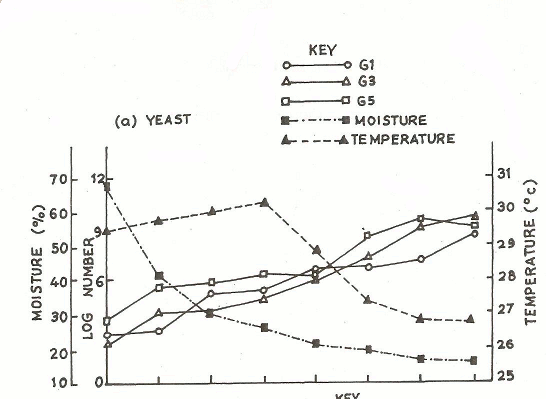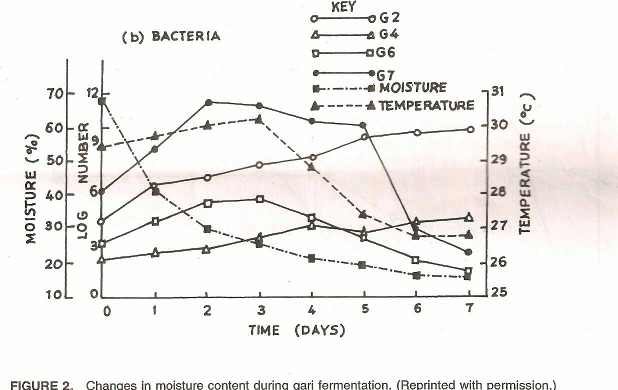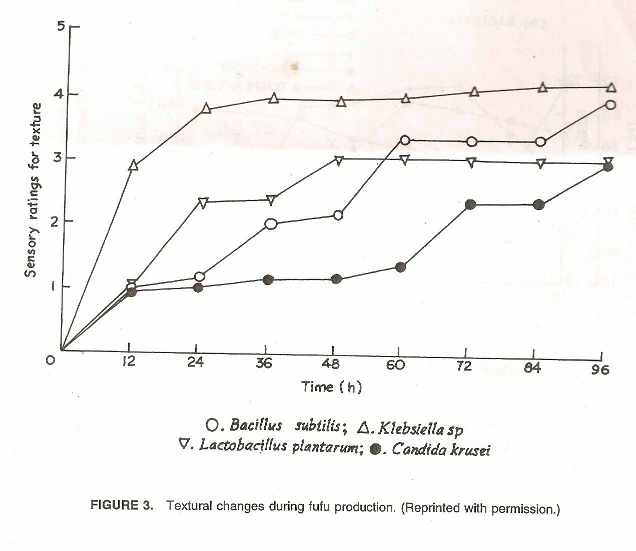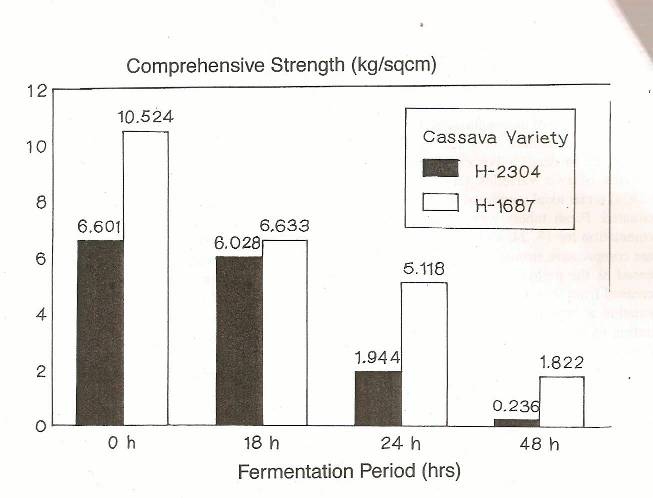Cassava Fermentation and Associated Changes in Physicochemical and Functional Properties
Prev Page | Next PageIII. Changes in Physical Characteristics
Fermentation brings about perceptible changes in the physical characteristics such as dry matter content, texture, and appearance of the tubers, and these are described in the following paragraphs.
A. Dry Matter
Dry matter content in gari and fufu produced by different methods have been compiled (Table 3). Oteng-Guang and Anuonye found a rapid decrease in dry matter during the third and fourth days of fufu fermentation. Oyewole and Odunfa reported that moisture content increased to 70.34% within first 36 h and then gradually decreased around 60% for the remaining period during lafun fermentation. The loss during the laster period was attributed to osmosis. The change in moisture content observed by these workers is in contrast to the results obtained by Nwachukwu and Edwards.
WAS
AND CUT TO
10cm PIECES
↓
100 ℓPUT PIECES IN A CONTAINER
ADD WATER TO HAVE 10 – 15CM
TOP LAYER
↓
2 ℓADD MOTHER LIQUOR AS INOCULUM TWO
PERCENT OF THE VOLUME OF WATER AND MIX
↓
COVER WITH MUSLIN CLOTH AND
INCUBATE FOR 48h AT AMBIENT TEMPERATURE (30-320C)
↓
DECANT STEEP LIQUOR AND
MASH THE TUBER
↓
↙↘
DISPENSE IN EXCESS
OF WATER, SIEVE,
ALLOW TO SETTLE,
SEDIMENT DRIED
TO GET SWF
SUN / OVEN DRIED,
SIEVE TO GET SRF
Source : MATHEW GEORGE
Figure 1. Flow chart for Sour and sweet flours.
Dry matter content in gari and fufu produced by different methods have been compiled (Table 3 ).47 Oteng-Guang and Anuonye found a rapid decrease in dry matter during the third and fourth days of fufu fermentation .48 Oyewole and Odunfa reported that moisture content increased to 70.34% within first 36 h and then gradually decreased around 60% for the remaining period during Lafun fermentation. The loss during the later period was attributed to osmosis.36 The change in moisture content observed by
Table 1.
(A) Changes in Dry matter and Starch Content of Cassava during Gari Preparation
| Item | Dry Matter2 | Starch2 (g/100 g) |
|---|---|---|
| Starting mash | 37.6a±0.5 | 87.7a±3.1 |
| 24 h fermentation | 40.9a±0.5 | 82.7a±3.2 |
| 48 h fermentation | 40.7a±1.3 | 85.4a±5.2 |
| 24 h pressing | 48.7a±2.8 | 80.7a±2.8 |
| 48 h pressing | 50.3a±1.0 | 79.4a±6.4 |
| Roasting | 84.5a±0.9 | 86.2a±2.8 |
(B) Changes in Dry Matter Content of Cassava during Lafun Preparation
| Item | Dry Matter2(%) |
|---|---|
| Mash | 39.3a±0.07 |
| 5-d soaking | 39.9a±0.53 |
| 5-d soaking + 48 h drying | 86.5a±2.30 |
| 5-d soaking + 96 h drying | 86.2a±0.12 |
Note:
1. Means in each column with a dissimilar letter are significantly different according to Duncan’s Multiple Range Test (p < 0.01).
2. Average of nine determinations (triplicates for each harvest period)
Source: Keitku et al.45
These workers in contrast to the results obtained by Nwachuku and Edwards.12
The effect of fermentation with amixed culture inculum on the dry matter content in four varieties has been examined. The dry weight showed a decrease in all the four varities. The maximum decrease was found within 24 to 48 h in all cases. The decrease in dry matter can be partly due to reduction in sugar and starch contents. In addition, the softening of tubers may be leading to increased absorption of water, contributing to the reduction in dry weight.44
B. Softening of Roots
During the soaking of roots for production of gari, fufu, or Lafun, the texture of the roots undergo noticeable change and the roots are rendered soft. A few attempts have been made to quantify the softening and use it as an index to monitor the extent of fermentation. Generally, it has been observed that the softening of tubers sets in during the second day and continues until the fourth day in the traditional fermentation. Among the different cultures tried for fufu production, B. subtilis showed the highest of softening capability (Figure 3).32
Ampe et al. has used softening of tissues as an index for determining the retting velocity.49 In this study, the softening was monitored using a penetrometer and the values used to determine the time taken for fermentation. Based on the results, the optimum conditions for the production of fufu were standardized. The effect of fermentation on three varieties having different textural characteristics has been studied.50 The rate of tissue disintegration during fermentation did not follow any definite pattern with respect to texture index or hardness of cooked tissues. However, the texturally intermediate type was found to be most resistant to tissue breakdown during fermentation (retting).
Analysis of the textural changes taking place during 12 h fermentation of tubers under laboratory conditions indicated that microorganisms in cassava fermentation may include softening by producing proteolytic enzymes that activate enzyme polygalactouronase in cassava tissues.51
The rate of softening of tubers was enhanced with decrease in size of tuber pieces and a temperature of 30 to 40*C and duration of 48 h facilitated good retting requird for fufuf production.31
The softening of tubers during fermentation by a mixed culture incolumn has been investigated in detail.52 Force deformation behavior of two varieties (H-1687 and H-2304) under axial compression loads was evaluated. Fresh tubers were subjected to fermentation for 18, 24 and 48 h. The ultimate compressive strength of the tubers decreased as the period of fermentation was increased from 0 to 48 h (Table 4). The deformation at rupture values increased with duration of fermentation. This was true for the two varieties examined, but the difference in the initial compressive strengths was observed between them. The reduction in initial compressive strength was 8.54% for H-2304 and 20.06% for H-1687 after 48 h fermentation (Figure 4).
The typical load deformation behavior of the tubers after fermentation has also been examined. The fermented tuber specimen started ‘flowing’ during the later half of compression tests resulting in higher deformation without an appreciable increase in the compressive load. The effect is directly related to fermentation period. This implies that cutting of tubers may not be so easy after fermentation. Tubers of H-2304 fermented for 24 h were having similar compressive strength as tubers of H-1687 fermented for 48 h. The results indicate that original compressive strength is a characteristic inherent to the variety and hence the period of fermentation for optimum softening depends on variety. Thus, the optimum period of fermentation may be taken as 24 h for H-1687 and 48 h for H-2304.
Table 2
Changes in Moisture Content, pH Value and Titratable Acidity during the Gari Fermentation Using fresh Cassava and Cassava that had been frozen as Raw Materials.
| Moisture Content(%) | pH Value | TTA (lactic acid) | Log Viable Count | |||||||
|---|---|---|---|---|---|---|---|---|---|---|
| SPC | LAB | |||||||||
| Time (d) | Fresh | Frozen | Fresh | Frozen | Fresh | Frozen | Fresh | Frozen | Fresh | Frozen |
| 0 | 64.7 | 64.3 | 6.4 | 6.3 | 0.09 | 0.11 | 2.5 | 2.7 | 3.1 | 3.9 |
| 1 | 64.7 | 64.3 | 6.4 | 6.3 | 0.09 | 0.11 | 2.5 | 2.7 | 3.1 | 3.9 |
| 2 | 64.7 | 64.3 | 6.4 | 6.3 | 0.09 | 0.11 | 2.5 | 2.7 | 3.1 | 3.9 |
| 3 | 64.7 | 64.3 | 6.4 | 6.3 | 0.09 | 0.11 | 2.5 | 2.7 | 3.1 | 3.9 |
| 4 | 64.7 | 64.3 | 6.4 | 6.3 | 0.09 | 0.11 | 2.5 | 2.7 | 3.1 | 3.9 |
| Gari | 7.8 | 8.2 | ||||||||
Note: SPC, standard place count, plate count agar. LAB, lactic acid bacteria, MRS agar.
Source : Vasconcelos.
Figure 2. Changes in moisture content during gari fermentation. (Reprinted with permission)
(a) Bacteria

(b) Yeast

Table 3
Analysis of Traditionally Produced Gari and Mechanized Product Compared with Fufu
| Constituent | Village Gari | FIIRO gari | FIIRO cassava fufu |
|---|---|---|---|
| Carbohydrate Content (by difference) (%wt) | 81.8 | 87.0 | 73.0 |
| Water Content(%) | 14.4 | 8.2 | 8.6 |
| Oil Content(%) | 0.12 | 0.1 | 0.44 |
| Crude Protien(%) (N x 6.25) | 0.9 | 1.5 | 1.26 |
| Crude Fiber (% wt) | 1.4 | 2.3 | 1.6 |
| Ash (%wt) | 1.4 | 0.9 | 0.15 |
| Calcium (mg/100g) | 17.7 | 45.6 | – |
| Iron (mg/100g) | 2.0 | 2.2 | 0.0015 |
| Phosphorous (mg/100g) | 57.2 | 56.9 | 0.02 |
| HCN Content (ppm) | 19.0 | 10.0 | 16.0 |
| Swelling (%vol) | 32.0 | 300.0 | – |
Source: Steinkraus47
Figure 3
Textural changes during fufu production.(reprinted with permission)

Softening of tissues during fermentation can be attributed to enhanced action f pectinolytic and celluloytic enzymes produced by the microorganisms. The softening will be very helpful in size reduction operations such as crushing or grinding. Fermentation of Cassava is a microbial degradative process whereby the firm tuber is broken down into soft, easy, disintegratable lump. The degradation process is belived to principally involve the structural framework that binds the starch molecules.53 The enhanced activity of cellulose and pectinolytic enzymes, pectin methyl esterase and polygalacturonase, during the course of fermentation of cassava inoculated with a mixed culture inoculum facilitating cell maceration is reported.17 The effect of fermentation on the softening of tubers and the involvement of proteolytic enzymes in the process has been studied in detail.51 The ability of mixed culture inoculum to bring about softening in seven popular varieties of cassava during bulk fermentation, facilitating production of fermented sour flour (SRF) is brought out in Table 5. The dry weight of the tuber influenced the quantity of SRF produced. Thus, Mankuzhanthan, which had the highest tuber dry weight, yielded the maximum quantity of SRF, while H.165 had the least. However, the efficiency index of product recovery (EI) is influenced by the cooking quality of the tuber. The direct involvement of the structural framework of cell in deciding traits of cooking quality and softening of tuber may probably explain the higher EI observer for the mealy type of tuber from M4 and Ambakadam.54 It was also observed that the cells of cooked tubers were held less cohesively, that is, there was more cell disintegration in mealy varieties than in non-mealy ones.55
Table 4
Effect of Fermentation Period on Compressive Strength and Deformation of Peeled Cassava Tubers (H 2304) Under Axial Loading
| Duration of Fermentation h |
Comprehensive Strengtha Kg/cm2 |
Deformationa at failure % |
Tuberb diameter cm |
Radius of gyration cm |
Slendernes ratio |
|---|---|---|---|---|---|
| 0 | 6.827 (0.89) |
10.92 (2.11) |
4.57 (0.8) |
1.62 | 6.17 |
| 18 | 6.479 (0.70) |
12.08 (2.06) |
6.16 (0.62) |
2.18 | 4.59 |
| 24 | 2.389 (0.54) |
13.12 (1.41) |
4.84 (0.55) |
1.71 | 5.85 |
| 48 | 0.583 (0.24) |
7.53 (3.16) |
4.84 (0.61) |
1.71 | 5.85 |
Note : Standard deviation values in parenthesis. Length of tuber specimen: 10cm each.
a Average of atleast 4 test runs.
b Average of atleast 16 observations.
Source: Nanada and Mathew George52.
Graph figure 4: comprehensive strength of fermented tubers. (reprinted with permission)



